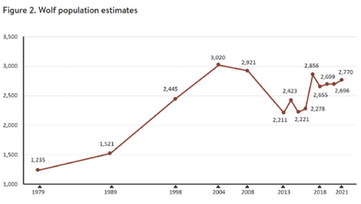A recent wolf sighting on Nov. 7, 2025 on the Ely School District grounds while kids were in class has one Minnesota lawmaker renewing his call for delisting the gray wolf from the federal Endangered Species Act (ESA) list.
U.S. Rep. Pete Stauber, who represents the Eighth Congressional District in northern Minnesota, said, “The science is clear—the gray wolf has recovered and must be delisted under the Endangered Species Act. Failing to do so threatens the safety and livelihood of our farmers with the loss of their livestock, and safety of the countless individuals across Northern Minnesota—including students in Ely where a wolf was recently spotted roaming school grounds in the middle of the school day.
“Throughout my time in Congress, I have led the charge to delist the gray wolf, and I am helping lead the Pet and Livestock Protection Act, which I am hopeful will be brought up and passed through the House before the end of the year. Once it does, I hope Minnesota’s U.S. Senators, Amy Klobuchar and Tina Smith, will join me in voting to protect our constituents and finally delist the gray wolf.”
A matter of public safety Minnesota manages its wolf population with a state-level plan, and currently under the threatened status, wolves can only be killed in defense of human life, while government agents can dispatch them to protect livestock. Public safety is one of the objectives of the state’s wolf management plan.
Rep. Stauber, R-Minn., has been working during his time in Congress — in a traditionally blue voting area — to address the issue of delisting the gray wolf from federal protection. Main prey for wolves are deer, moose and beaver. However, there are ongoing issues with cattle and pets being attacked and eaten by wolves.
Now, the latest is yet another public safety concern — a lone wolf walking on the Ely School District grounds while school was in session. Trying to help local farmers, ranchers, hunters and residents get their public safety concerns heard, Stauber continues to raise awareness.
At the core of this issue is how agencies define what a sustainable wolf population in Minnesota is, and when steps are taken to address changes in the population.
Population levels and distribution
The ESA designations were created to assist with a species recovery when numbers become too low, which is no longer the case in Minnesota.
The status of the gray wolf in Minnesota is threatened under federal protection, despite a recovered and large population. The most recent population data was estimated mid-winter of 2023 with 2,919 wolves (+/- 800).
Minnesota’s wolf population has experienced periods of annual increase, with average annual growth rates of about 6% in the 1970s, 3% in the 1980s, and 4.5% in the 1990s, according to the International Wolf Center. More recently, the population has been relatively stable, fluctuating between 2,400 and 3,000 wolves, though it can experience localized increases or decreases depending on factors like prey availability and pup survival rates.
Data from the most recent DNR wolf plan does not include 2023 data, which is a significant increase. According to the DNR’s wolf plan, Appendix 2, when the population exceeds 3,000, they will “consider additional public engagement and wolf management actions to address depredation or other public concerns.”
Appendix 2 contains the framework for the DNR to use in deciding whether and how to establish a proposed wolf season if federal Endangered Species Act protections are again removed. Tribal governments must be consulted regarding the potential for a season consistent with Minnesota Statutes, as well as the DNR providing an opportunity for public comment.
Using 2023 data, there were 2,919 wolves (+/- 800). If +400 is used, the total population would be 3,319. Staying moderate and using the 4.5% increase annual growth rate, then the 2024 population may equal 3,468. If that type of trend continued for the current year, the wolf population could be as high as 3,624.
Wolves are concentrated in the northern third of the state, with a home range of over 27,000 square miles.
State and federal agency responses There has been a long and contentious battle about the wolf population. The U.S. Fish and Wildlife Service (USFWS) has attempted to delist wolves multiple times due to population recovery.
According to the DNR’s updated wolf management plan, “The USFWS published a rule removing wolves from the endangered species list in 2021, and this decision was overturned by a federal court ruling in 2022.
“Although the state had been actively supporting wolf conservation for decades, the DNR, in consultation with the Minnesota Department of Agriculture (MDA), adopted its first wolf management plan in 2001. That plan was initiated in response to the USFWS recommendation to remove federal Endangered Species Act protections for the gray wolf.”
USFWS: In 1992, the revised USFWS Recovery Plan for the Eastern Timber Wolf set a population recovery goal for Minnesota at 1,251 to 1,400 wolves. By 2001, the population was roughly double the upper end of that goal.
DNR: The state’s goal for the wolf population was expanded to “provide a buffer” and identified a minimum of 1,600 wolves, which it says is consistent with a healthy and resilient population across a suitable range. No maximum population goal was established.
The DNR website says it is “committed to ensuring the long-term survival of the wolf in Minnesota and minimizing and resolving conflicts between wolves and humans.”
The USFWS announced earlier this month that it no longer intends to release a national recovery plan that was proposed by the Biden administration.
This article was originally published by Alpha News












